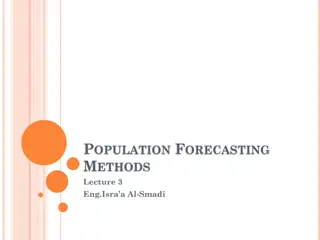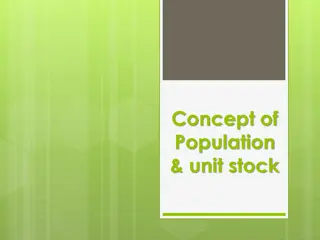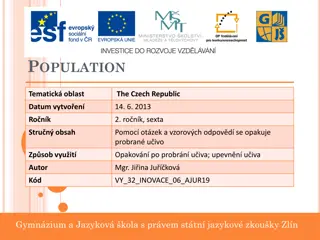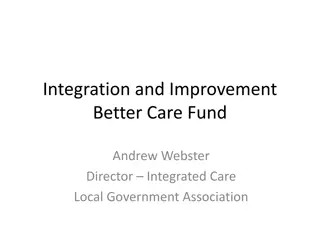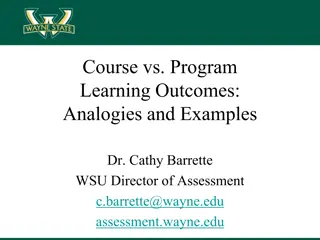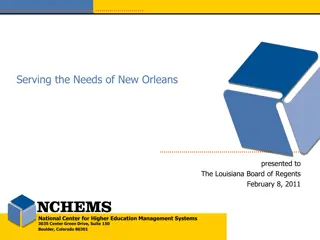Understanding Population Health Management for Better Health Outcomes
Population Health Management (PHM) integrates various healthcare services to improve the health and wellbeing of a defined population using evidence-based strategies. It focuses on addressing modifiable health determinants, achieving healthcare aims, and enhancing long-term health outcomes through efficient resource allocation.
- Population Health Management
- Healthcare Integration
- Modifiable Determinants
- Efficient Resource Allocation
- Health Outcomes
Download Presentation

Please find below an Image/Link to download the presentation.
The content on the website is provided AS IS for your information and personal use only. It may not be sold, licensed, or shared on other websites without obtaining consent from the author. Download presentation by click this link. If you encounter any issues during the download, it is possible that the publisher has removed the file from their server.
E N D
Presentation Transcript
The critical role you play in your population s health The role of health, wellbeing and the wider determinants of health and the risks over medicalisation of PHM The challenges of system working and creating a common language for change The critical role of finance in PHM Andi Orlowski Director of the Health Economics Unit Senior Population Health Analytics Advisor NHS England (Data and Analytics Directorate)
3 What do we mean by Population Health Management? A local system that: integrates primary care, secondary care and community health services with public health, social care and Third Sector organisations manages a defined budget on behalf of a defined geographical population uses evidence and person-level analysis to: understand the health needs and wellbeing of its population and identify opportunities to improve the quality, efficiency and equity of the care being provided inform the planning and investment in a range of coordinated, evidence-based, cost-effective health, care and social interventions monitor and evaluate interventions to learn what works for whom, where and why in order to: reduce health inequalities achieve the triple aim of healthcare (higher quality care, better patient experience, lower per capita cost) improve the long-term health and wellbeing of the people it serves.
Modifiable health determinants 20% 30% 10% 40% health behaviors social and economic factors physical environment clinical care 4
6 Allocative efficiency, PHM, the Hewitt review and you Wider determinants 1 in 5 dwellings doesn t meet decent standards in England 1 in 5 people live in poverty in the UK Children in deprived areas are 9 times less likely to have access to green space and places to play By the age of 30 those with the highest levels of education are expected to live 4 years longer than those with the lowest education
7 Allocative efficiency, PHM, the Hewitt review and you Life expectancy Men Disease free life expectancy ~55 (highest deprivation) to ~70 (least deprivation) Life expectancy ~74 (highest deprivation) to ~84 (least deprivation) Women Disease free life expectancy ~55 (highest deprivation) to ~72 (least deprivation) Life expectancy ~78 (highest deprivation) to ~86 (least deprivation) https://www.health.org.uk/publications/reports/the-marmot-review-10-years-on?
8 Presentation Title Here Upstream/Macro Greater medicalization Proportion of effort Proportion of effort Downstream/Micro
9 Presentation Title Here It is key to the success of risk stratification to ensure that high- risk individuals are not conflated with those most likely to benefit as there is evidence indicating that these can be highly separated groups [Orlowski et al. 2021].
Delivering on the promise of systems
There is little convincing evidence to suggest that collaboration between local health care and non-health care organisations improves health outcomes 11 Alderwick, H., Hutchings, A., Briggs, A. et al. The impacts of collaboration between local health care and non-health care organizations and factors shaping how they work: a systematic review of reviews. BMC Public Health 21, 753 (2021). https://doi.org/10.1186/s12889-021-10630-1
12 Alderwick, H., Hutchings, A., Briggs, A. et al. The impacts of collaboration between local health care and non-health care organizations and factors shaping how they work: a systematic review of reviews. BMC Public Health 21, 753 (2021). https://doi.org/10.1186/s12889-021-10630-1
13 Aunger, J.A., Millar, R., Greenhalgh, J. et al. Why do some inter-organisational collaborations in healthcare work when others do not? A realist review. Syst Rev 10, 82 (2021). https://doi.org/10.1186/s13643-021-01630-8
Meanwhile in the real world
Improving social and economic factors: Wakefield Reducing homelessness Wakefield have been working as a partnership to prevent eviction and potential homelessness Mental health navigators take referrals from Wakefield District Housing Debt Team, housing officers and community safety officers on problems like hoarding, poor tenancy management and anti-social behaviour. The team engaged with over 150 clients and the wellbeing caseworkers carried out over 400 interactions yielding a social return of 1.1 million. 20% 30% 10% 40% health behaviors social and economic factors physical environment clinical care
Improving the physical environment: London Traffic calming measures for public health benefit Guy s and St Thomas charity paid 250k to install traffic calming measures for public health benefits including tackling air pollution and obesity in Lambeth and Southwark The Low Traffic Neighbourhoods will be focused in the areas of highest deprivation in the area The aim is to reduce traffic and improve access for cyclists and pedestrians - including widening pavements, adding seating and roadside markings to encourage walking and cycling and removing parking spaces. 20% 30% 10% 40% health behaviors social and economic factors physical environment clinical care
Improving the physical environment: North East Improving homes in Sunderland and Scotland Gentoo and Sunderland CCG provided energy efficient boilers, double glazing and insulation on prescription A&E attendances reduced by 30%. Emergency admissions reduced by 25%. GP appointments reduced by 60% Patients suffering from respiratory diseases that are exacerbated by the cold, such as COPD, were referred onto the scheme and received improvements totalling on average 5,000 per property. 20% 30% 10% 40% health behaviors social and economic factors physical environment clinical care
18 Multi-Criteria Decision Analysis (MCDA) MCDA is a decision-making tool that helps individuals or organizations evaluate multiple criteria when making complex decisions. It involves the use of mathematical models and techniques to weigh and compare various alternatives against each other based on different criteria. MCDA is widely used in various fields such as business, engineering, environmental management, and healthcare.
19 A programme to embed allocative value in NHS decision making The Health Economics Unit are leading a development programme on allocative efficiency across systems in the Midlands. Using COPD as an exemplar pathway, HEU will run the STAR process with: Birmingham and Solihull ICS Coventry Place Northamptonshire ICS Nottinghamshire ICS Gloucester ICS Through the Midlands Decision Support Network, the HEU will run a training programme on allocative value and the STAR method.
Executive Summary: Smarter Spending in Population Health 20 Process The project aimed to understand how to increase allocative efficiency of the COPD pathway in Nottinghamshire. It was facilitated through the following process: Collaborative workshops to value the pathway and identify improvements: Model pathway improvements in terms of costs and population health: Collect data and evidence on the pathway: >500 COPD patients completed a preferences survey 11 pathway improvements were modelled using methods validated by LSE 22 attendees contributed to two in-person workshops >64 publications were part of the literature review Attendees included patients, COPD clinical specialists, public health, finance, informatics, analysts and transformation. Five pathway improvements are recommended for implementation due to the modelled cost and population health gain. >100 data points were collected looking at costs, activity and health gain. More details on the project process are on page 12
Executive Summary: Smarter Spending in Population Health 22 Recommendations The following pathway improvements have been modelled and are recommended for implementation as they are likely to lead to the most health generation per pound spent. Making every contact count very brief advice on smoking cessation Conducting patient s yearly reviews through group consultations Improving case-finding by targeted COPD screening Introducing referral pathways to Breathe Easy Improving uptake to smoking cessation services Yearly savings through early diagnoses (> 1.3m) Cost saving through reduction in AECOPDs (~ 2,000) Cost inducing but effective ( 69k - 76k) Inexpensive intervention (< 2,700) Cost neutral ~2,600 additional cases of COPD identified per year ~1,088 more quitters per year ~6,074 more patients having a yearly review Large net population health gain for cost ~243 quitters per year Address priority: Stopping more people from smoking and helping more people to quit Address priority: Stopping more people from smoking and helping more people to quit Address priority: Improving case management in primary care Address priority: Improving case management in primary care Address priority: Improving uptake of tertiary prevention services If implemented, these interventions are expected to result in 408k-872k increase on costs and a 34.24 percentage point increase to population health (best case scenario).
Executive Summary: Smarter Spending in Population Health 23 Process The project aimed to understand how to increase allocative efficiency of the COPD pathway in Gloucestershire. It was facilitated through the following process: Collaborative workshops to value the pathway and identify improvements: Model pathway improvements in terms of costs and population health: Collect data and evidence on the pathway: >500 COPD patients completed a preferences survey 12 pathway improvements were modelled using methods validated by LSE 28 attendees contributed to two in-person workshops >64 publications were part of the literature review Attendees included patients, COPD clinical specialists, public health, finance, informatics, analysts and transformation managers. Five pathway improvements are recommended for implementation due to the modelled cost and population health gain. >100 data points were collected looking at costs, activity and health gain.
Executive Summary: Smarter Spending in Population Health 25 Recommendations The following pathway improvements have been modelled and are recommended for implementation as they are likely to lead to the most health generation per pound spent. More effective use of the virtual ward Improving uptake to Mindsong and KiActiv Very brief advice (VBA) for tobacco dependency Increasing uptake of PR (online offering) Proactive case finding Yearly savings through avoided admission (~ 2,500) Possible ~ 7 saved for every 1 spent ~ 2 saved for every 1 spent ~ 5 saved for every 1 spent Cost neutral Scalable option to increase PR engagement Reducing risk of hospital acquired infection 102 additional people accessing services Increased early diagnosis Linked to a 66% increase in quitting rate Priority addressed: Managing acute exacerbations more efficiently Priority addressed: Enhancing the role of social prescribing and awareness of services Priority addressed: More proactive and earlier interventions in primary care Priority addressed: Enhancing the role of social prescribing and awareness of services Priority addressed: Creation of a tobacco prevention and treatment alliance If implemented, these pathway improvements are expected to be cost saving. They are estimated to save 1.04m net per year and lead to a 12.4% percentage point increase to population health.
Executive Summary: Smarter Spending in Population Health 26 Process The project aimed to understand how to increase allocative efficiency of the COPD pathway in Birmingham and Solihull. It was facilitated through the following process: Collaborative workshops to value the pathway and identify improvements: Model pathway improvements in terms of costs and population health: Collect data and evidence on the pathway: >500 COPD patients completed a preferences survey 13 pathway improvements were modelled using methods validated by LSE 20 attendees contributed to two workshops >64 publications were part of the literature review Attendees included COPD clinicians, public health, finance, informatics, analysts and transformation managers. Five pathway improvements are recommended for implementation due to the modelled cost and population health gain. >100 data points were collected looking at costs, activity and health gain.
Executive Summary: Smarter Spending in Population Health 28 Recommendations The following pathway improvements have been modelled and are recommended for implementation as they are likely to lead to the most health generation per pound spent. Promoting respiratory services within localities through social prescribing physical activity Increasing uptake of smoking cessation services (Tertiary prevention Quit with Bella app) Virtual ward as early discharge support Expanding spirometry testing Introducing the myCOPD app Up to 163k savings a year due to early diagnosis 0.01 for every additional unit of population health gain 0.26 for every additional unit of population health gain Yearly savings through avoided admission (~ 1.8m) 0.23 for every additional unit of population health gain 1 hospital admission avoided for every 70 people treated 4,194 fewer bed days required for COPD patients per year ~11,000 people receiving self care support a year 1 avoided case of COPD for every 88 people who quit 94 fewer hospital admissions a year Priority addressed: Prevention and promotion of healthier communities National priority addressed: Expand virtual wards Priority addressed: Accurate and timely diagnosis Priority addressed: Living well Priority addressed: Living well If implemented, these pathway improvements are expected to be cost saving. They are estimated to save ~ 1.8m net per year and lead to a 52.46% percentage point increase to population health.
30 Recommendations for Coventry As a result of this project, it is recommended that the respiratory programme prioritises the following pathway improvements: Expansion of the virtual ward. Joint clinics in primary care with the current establishment of Respiratory Nurse Specialists. Targeting spirometry testing and improving diagnosis An education package for people with COPD. Education in schools against smoking and vaping. The estimated savings from the virtual ward, 553,523.40 per year, could save enough to cover most of the additional cost of these improvements if the resource could be freed up
Questions andi.orlowski@nhs.net https://healtheconomicsunit.nhs.uk/












